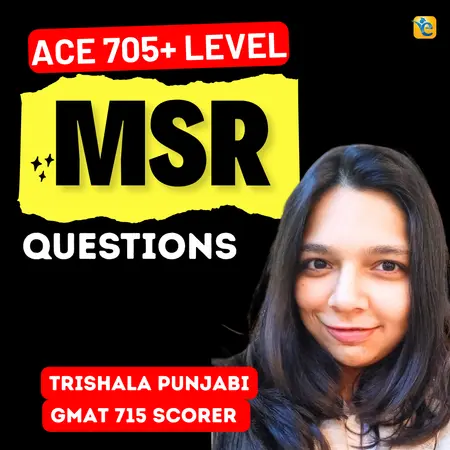Events & Promotions
|
|

GMAT Club Daily Prep
Thank you for using the timer - this advanced tool can estimate your performance and suggest more practice questions. We have subscribed you to Daily Prep Questions via email.
Customized
for You
Track
Your Progress
Practice
Pays
Not interested in getting valuable practice questions and articles delivered to your email? No problem, unsubscribe here.
- Nov 22
11:00 AM IST
-01:00 PM IST
Do RC/MSR passages scare you? e-GMAT is conducting a masterclass to help you learn – Learn effective reading strategies Tackle difficult RC & MSR with confidence Excel in timed test environment - Nov 23
11:00 AM IST
-01:00 PM IST
Attend this free GMAT Algebra Webinar and learn how to master the most challenging Inequalities and Absolute Value problems with ease. - Nov 25
10:00 AM EST
-11:00 AM EST
Prefer video-based learning? The Target Test Prep OnDemand course is a one-of-a-kind video masterclass featuring 400 hours of lecture-style teaching by Scott Woodbury-Stewart, founder of Target Test Prep and one of the most accomplished GMAT instructors.
megafan
Joined: 28 May 2009
Last visit: 15 Oct 2017
Posts: 137
Given Kudos: 91
Location: United States
Concentration: Strategy, General Management
Schools: Stern PT Fall'18 Booth PT '18
GMAT Date: 03-22-2013
GPA: 3.57
WE:Information Technology (Consulting)
Kudos
Bookmarks
A
Be sure to select an answer first to save it in the Error Log before revealing the correct answer (OA)!
Difficulty:
 55%
(hard)
55%
(hard)
Question Stats:
60% (01:49) correct 40%
(02:14)
wrong
40%
(02:14)
wrong  based on 538
sessions
based on 538
sessions
History
Date
Time
Result
Not Attempted Yet
For any integer m greater than 1, $m denotes the product of all the integers from 1 to m, inclusive. How many prime numbers are there between $7 + 2 and $7 + 10, inclusive?
(A) None
(B) One
(C) Two
(D) Three
(E) Four
(A) None
(B) One
(C) Two
(D) Three
(E) Four
Kudos
Bookmarks
megafan
$ is basically a factorial of a number.
So, we are asked to find the number of primes between 7!+2 and 7!+10, inclusive.
From each number 7!+k were \(2\leq{k}\leq{10}\) we can factor out k, thus there are no pries in the given range.
For example:
7!+2=2(3*4*5*6*7+1) --> a multiple of 2, thus not a prime;
7!+3=3(2*4*5*6*7+1) --> a multiple of 3, thus not a prime;
...
7!+10=10(3*4*6*7+1) --> a multiple of 10, thus not a prime.
Answer: A.
Hope it's clear.
General Discussion
Kudos
Bookmarks
Nice way to solve the problem. If you factor out the k, it should be
7!+3=3(2*4*5*6*7+1)
...
7!+10=10(3*4*6*7+1)
7!+3=3(2*4*5*6*7+1)
...
7!+10=10(3*4*6*7+1)
Quote:













